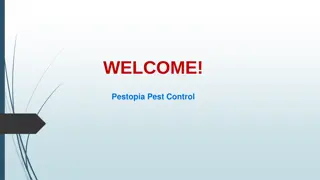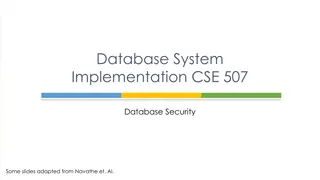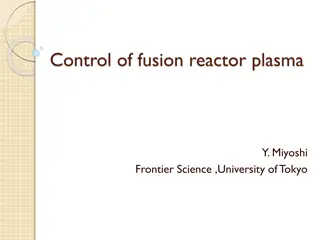Understanding Control Plans in Process Management
Control plans are essential tools for managing process risks and ensuring quality control. They focus on controlling process and product characteristics, meeting customer requirements, and having reaction plans in place. A control plan contains key information such as control factors, specifications, measurement systems, sample size, control methods, and reaction plans. Objectives of control plan training include understanding and developing control plans and linking them to Failure Mode and Effects Analysis (FMEA). Control plans provide a systematic approach to defining characteristics, methods, and actions for process control, verification, and auditing. Inputs to control plans may include tools like FMEA, flow charts, assembly drawings, and historical data.
Download Presentation

Please find below an Image/Link to download the presentation.
The content on the website is provided AS IS for your information and personal use only. It may not be sold, licensed, or shared on other websites without obtaining consent from the author. Download presentation by click this link. If you encounter any issues during the download, it is possible that the publisher has removed the file from their server.
E N D
Presentation Transcript
Control Plans Page 2
Control Plan Control Plans: Control the risks identified in the P-FMEA (High RPNs) A structured approach to control process and product characteristics Focusses on Customer Requirements Assure reaction plans are in place in case of out-of-control conditions Provide a central document for communication of control methods A Control Plan contains following key information: Identification of the control factors The specifications and tolerances The measurement system Sample size and frequency The control method The reaction plan Control Plans are living documents, just like FMEA s 3 Page 3
Control Plan, Objectives Objectives of the training: To understand the use of a Control Plan To learn the steps to develop a Control Plan To learn how to link each step in the Control Plan to the FMEA 4 Page 4
Control Plan, Summary Control Plan, a systemic way to Control a process: Define Characteristics per process step: Machines, Devices, Jigs and Tools Product, Process and Special characteristics Define Methods per process step: Process and Product Specifications and Tolerances Measurement and Inspection techniques Sample size and frequency Actions that should be taken in case of Non Conformities 5 Page 5
Control Plan, Summary Control Plan, a systemic way to Control a process: Verify if defined steps are followed Audit the process by Control Plan on a regular base Update the Control Plan consistently 6 Page 6
Benefits Control Plan, Inputs Control Plan, inputs might include following tools: FMEA Flow Chart (process sequence) Lay-out Plan production line Sequence Of Events Part Number/ Tooling / Tool List Assembly Drawing Specifications/ Dimensions/ Tolerances CTQ List Process Map Historical OMS 7 Page 7
Control Plans, Planning A build B build Pilot SOP Drawing Issue part approval form Tool development FMEA + control plan Fit / performance 1. Conditional approval HVPT approval 3. Part approval QA 2. Purchasing SQE Source SQE approval Quality and capacity confirmation HVPT process approval Issue HF PA requirements HF proto part approval MF and LF part receipt HF full part approval (OT/OP) Inspection OK NOK send CAR s Page 8 VCB approval
Control Plans Prototype Control Plan Number Pre-launch Production Date (Original) Key Contact/Phone Part Number/Latest Change Level Core Team Date (Revised) Part Number / Description Plant / Supplier Approval Date Customer Eng.'s Approval / Date (if Required) Customer Quality Approval / Date (if Required) Plant / Supplier Other Approval / Date (if Required) Supplier Code Characteristics Methods Part / Process Number Machine Device Jig. Tools for Manufacturing Special Process Name / Operation Description Reaction Plan Sample Characteristics Class Product/Process Specification tolerance Evaluation Measurement Technique No. Product Process Control Method Size Freq. 1 2 3 4 5 6 7 8 9 10 11 12 A B C D Operation Methods Characteristics Reaction Plan Advanced Product Quality Planning (APQP) Reference Manual, QS-9000 Page 9
Control Plans MACHINE, DEVICE JIG, TOOLS FOR MFG. What is being done? PART/ PROCESS NUMBER PROCESS NAME/ OPERATION DESCRIPTION A Operation LTVL010 8416010, FRAME, 1x 1 1. Part/Process Number: Usually referenced from the process flow chart, PFMEA or Tool sheets 2. Process Name/Operation Description: Identify the process/operation that best describes the activity being addressed (e.g. work elements) Use verb / noun format 3. Machine, Device, Jig, Tools for Manufacturing: Identify the processing equipment required. (e.g.. machine, device, jig power tools, assist arms, conveyors, etc.) Page 10
Control Plans MACHINE, DEVICE JIG, TOOLS FOR MFG. What is Important? CHARACTERISTICS SPECIAL CHAR. CLASS NO. PRODUCT PROCESS 1 1 Appearance Inspect the frame Y Characteristics B 4. Number: Identifies the cross reference number from the applicable documentation. 5. Product Characteristic: Distinguishing features and/or attributes 6. Process Characteristic: Characteristics of the process 7. Special Characteristic: key processes (e.g. Delta K, QS) Page 11
Control Plans Characteristics: Identify Product and Process characteristics for each Control Plan step PROCESS CHARACTERISTIC PRODUCT CHARACTERISTIC identify characteristics, which when controlled, reduce variation in product characteristics physical properties of the part Identified important customer characteristics (CTQs and Delta-K) Examples: length, width, tensile strength, torque, weld integrity, color, alignment, etc. Examples: pressure, temperature, force, feed rate, RPM (torque), etc. A description of the state of the component or vehicle after the particular operation is completed Related to product characteristics Page 12
Control Plans What is the Means for Controlling? Methods C 8. Product/Process Specification: Specifications/tolerance for a part or process. (eg. may be obtained from various engineering documents) 9. Evaluation/Measurement Technique: Identifies the measurement system being used to measure product/process characteristics. (eg. gages, fixtures, test equipment, blocks, go/no go, etc) 10 / 11. Sample Size/Frequency: List sample size and frequency to perform evaluation. (eg. size: 4 pieces / frequency: fifth time per shift) METHODS REACTION PLAN PRODUCT/PROCESS SPECIFICATION/ TOLERANCE No damage EVALUATION/ MEASUREMENT TECHNIQUE Visual Inspection SAMPLE CONTROL METHOD SIZE FREQ. 1 1/Works hop OMS Inform Trainer Page 13
Control Plan, Sample size and frequency Benefits Until a process is Capable (Cpk 1.33), 100% Inspection is required If process is Capable, define Sample Size and Frequency reflecting acceptable risk Use Six Sigma tools and techniques to control the Process Xbar-R Chart of x 10-nov-08 1-nov-08 2-nov-08 3-nov-08 4-nov-08 5-nov-08 6-nov-08 7-nov-08 8-nov-08 9-nov-08 UCL=51.01 50 45 Station: Mee-1247 Mee-1248 Mee-1250 Mee-1251 Mee-1253 Mee-1255 Mee-1288 Mee-1289 Mee-1291 Mee-1256 Sample Mean __ X=39.42 40 Install O-ring C/R into C/C S/R assy S/R height V-coupling assy Act assy Lever welding Lever welding Act measurement Engraving Rev & K-ring check Mee-1257 Weld-assy-act C/C angle check V-coupl-lever-act 1 35 30 LCL=27.82 Counting Defects 1 2 3 4 5 6 SPC Chart Sample 1 UCL=20.15 20 1 2 3 1 15 Sample Range 10 2 2 1 3 _ R=6.17 5 1 0 LCL=0 1 2 3 4 5 6 Mee-1258 Mee-1259 Mee-1260 Total NOK Sample 1 4 2 3 2 1247 0 0 7 1 2 0 4 OK 220 450 300 350 455 275 400 430 C-Graph of Defects Capability Graph 1 4 Page 14
Control Plans, Control Method Methods C 12. Control Method: Brief description of how the operation will be controlled When selecting the method of control, focus on: process control rather than product control preventionrather than detection targeting nominal rather than specification limits Examples: - Check sheets (weld, quality, tool, material, etc) - Preventative tooling maintenance - Variation control charts - Error/mistake proofing - SPC charts METHODS REACTION PLAN PRODUCT/PROCESS SPECIFICATION/ TOLERANCE No damage EVALUATION/ MEASUREMENT TECHNIQUE Visual Inspection SAMPLE CONTROL METHOD SIZE FREQ. 1 1/Works hop OMS Inform Trainer Page 15
Control Plans, Reaction Plan D Reaction Plan 13. Reaction Plan: Specifies who to inform to make a decision or what to do when a process goes out of control Written for people closest to the process (e.g. replace a drill) Review systemic root cause and update the FMEA Examples: - Call supervisor - 100% Inspection until the process is back in control - Calibrate equipment METHODS REACTION PLAN PRODUCT/PROCESS SPECIFICATION/ TOLERANCE No damage EVALUATION/ MEASUREMENT TECHNIQUE Visual Inspection SAMPLE CONTROL METHOD SIZE FREQ. 1 1/Works hop OMS Inform Trainer Page 16
Control Plans, Plug Example Control Plan Number Key Contact/Phone Wytse Zijlstra Core Team Wytse Zijlstra, Stephen McLaughlin Supplier/Plant Approval/Date 15/10/2016 Other Approval/Date (If Req'd.) Date (Orig.) 05/10/2016 Date (Rev.) 1 1 Part Number/Latest Change Level PL30 Part Name/Description Plug assembly Supplier/Plant Hyster-Yale Group Customer Engineering Approval/Date (If Req'd.) N/A Customer Quality Approval/Date (If Req'd.) N/A Supplier Code Other Approval/Date (If Req'd.) H-Y N/A MACHINE, DEVICE JIG, TOOLS FOR MFG. CHARACTERISTICS METHODS PART/ PROCESS NUMBER PROCESS NAME/ OPERATION DESCRIPTION SPECIAL CHAR. CLASS REACTION PLAN PRODUCT/PROCESS SPECIFICATION/ TOLERANCE EVALUATION/ MEASUREMENT TECHNIQUE Visual Inspection SAMPLE CONTROL METHOD NO. PRODUCT PROCESS SIZE FREQ. PL-10 1010; 1 Plug face Code: PA320, White Bar Grip Rewireable 13A Resilient Plug Top Assembly Select 1 plug face with inside facing operator 100% OMS Inform Trainer PL-10 1345; 1 Cable Grip. 1060; 2 cable screws 1 Fit 1x Cable Grip using 2 cable screws. Screw hand tight Y Ensure Cable Grip screws go through back of cable grip Hand tight 100% OMS Adjust/ re-check PL-10 PL-20 Deliver batch of plugs to station 2 6789; 1 Fuse holder Box OMS OMS Inform Trainer Adjust/ re-check 2 Assembly Fit fuse holder Y Check correct location of the fuse holder Pin has fuse clamp on top Check if black band on pin Check if pins are in correct position 13 Amp fuse 5 Amp for Euro Visual Inspection 100% PL-20 1011; 1 Live pin 3 Assembly Fit 1 Live pin Y Visual Inspection 100% OMS Adjust/ re-check PL-20 1213; 1 Neutral pin with black band on pin 1415; 1 Earth pin 4 Assembly Fit 1 Neutral pin Y Visual Inspection 100% OMS Adjust/ re-check PL-20 Assembly Fit 1 Earth pin Visual Inspection 100% OMS Adjust/ re-check PL-20 1617; 1 fuse 13 Amp 1616; 1 fuse 5 Amp 5 Assembly Fit 1 fuse Y Visual Inspection 100% OMS Adjust/ re-check PL-20 Deliver batch of plugs to station 3 Box Deliver batch of plugs to station 3 Fit 1 screw to Neutral pin, Earth pin and Live pin and tighten hand tight with screw driver OMS Inform Trainer PL-30 2022; 3 screws to connect wires Screw driver 6 Assembly Y Ensure all screws are nipped tight and unable to undo by hand Hand tight 100% OMS Adjust/ re-check PL-30 PL-40 Deliver batch of of plugs to station 4 1819; Plug Front OMS OMS Inform Trainer Adjust/ re-check 7 Assembly Fit Plug Front Y Ensure all screws are tight Ensure text is readable Hand tight 100% PL-40 PL-40 2013; Wiring diagram Deliver batch of plugs to QA 8 Assembly Fit wiring diagram Y Visual Inspection 100% OMS OMS Adjust/ re-check Inform Trainer Box Page 17
Control Plans, Next Steps Next Steps to H-Y Suppliers: 1. Know your customers expectations - CTQ s (Critical to Quality Characteristics) Have a defined and documented production process (SOE) Follow 5S Principles Employ a formal training system Involve the people on the shop floor Audit the production process constantly Manage supplied parts and control supplier performance Measure/monitor key quality performance indicators Use an effective Corrective & Preventative Action Process 2. 3. 4. 5. 6. 7. 8. 9. FMEA and Control Plans are mandatory for PPAP submission level 3. Page 18
Control Plans, Next Steps Page 19
Quality Focus Day Workshop List of acronyms: CTQ: Critical To Quality, a characteristic judged to be important to the fit and function of a component or assembly as well as customer satisfaction FMEA: Failure Mode and Effect Analysis ICAM: Interactive Corrective Action Management OMS: Operational Method Sheet Off Tool: (Production Tooling) - When a part is said to be Off Tool it is required that the part be manufactured using the exact tooling which will be used for long-term production. This does NOT mean the parts were manufactured from tooling that is like or similar to the intended production tooling. Off Process:(Production Process) When a part is said to be Off Process it is required that the part be manufactured and tested using the exact process that will be used for long-term production. This does NOT mean the parts were manufactured using a like or similar or less than 100% completed process. P.A.: Part Approval process to determine if part characteristics and specifications are understood and met by the supplier. PCR: Process Change Request PFD: Process Flow Diagram SQM: Supplier Quality Manual QFD: Quality Function Deployment QS-9000, PPAP: Product Part Approval Process QS-9000, APQP: Advanced Project Quality Plan Page 20























